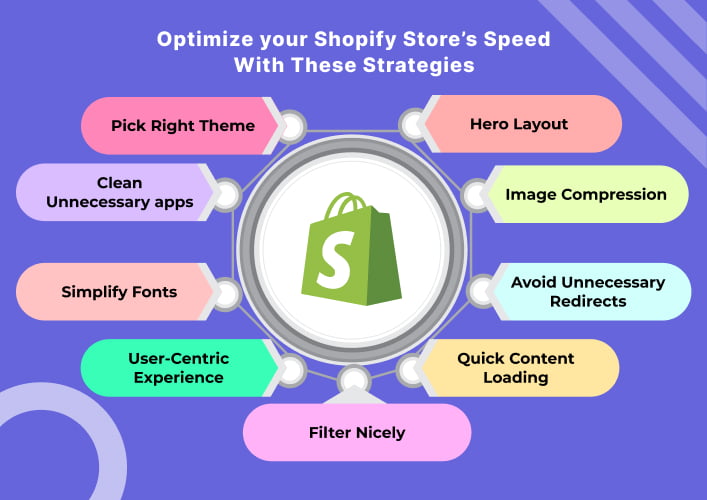Reasons To Optimize Your Shopify’s Page Speed
- The customer’s buying experience is impacted by how long it takes for the store’s page to load. The speedier your Shopify store, the happier your customers will be. Improve the shopping process and you’ll see a rise in user engagement, customer happiness, and a decrease in the number of abandoned carts.
- Furthermore, your Shopify store’s conversion rate will increase in direct proportion to how quickly its pages load.
- Your bounce rate will be immediately impacted. This is the worst point in SEO.
Important Elements That Affect Your Shopify Site Speed
Shopify site speed is affected by a wide variety of variables.
Uncontrollable Elements
Here are some external elements that you can’t change:
- Your clientele may be from all corners of the globe. Your Shopify visitors access the shop from a wide variety of devices and with varying speeds of internet connection. Thus, your Shopify store’s loading time will vary based on these aspects.
- Some parts of your Shopify shop are cached in the users’ local web browsers. Thus, the browser doesn’t have to repeatedly request the cached resources from the server. Now this is advantageous as it speeds up the loading time of your shop.
- The Shopify platform also does server-side caching of your online shop. Thus, customers will be sent a cached version of your store’s content, page loads will be accelerated.
Controllable Elements
Here are some external elements that you can change that slow down your Shopify store’s page load time:
- Your Shopify shop would have been customized with a number of different add-ons. You have enhanced the look and functionality of your shop with a variety of apps. Thus, you can reduce load time and optimize performance by reducing the number of unnecessary applications or using apps that has more than one feature.
- The performance of your Shopify store may be affected by the features you activate in your theme and apps. The more featured elements in your theme or app, the longer it will take for your shop to load. Allowing things that aren’t required for your consumers’ experience might slow down your shop and provide no value.
- Furthermore, your Shopify shop may take longer to load if you utilize many large-sized photos or videos. Customers may get impatient with your shop if they have to wait too long for the media to load.
- Several different font styles are available on Shopify. This may seem inconsequential, but it may prevent customers from reading your website if the font you’ve chosen isn’t installed on their device. The loading time of your shop’s webpage may be adversely affected.
Shopify Speed Optimization With These Strategies

- Selecting a theme that is both visually appealing and consistent with your brand is important, but you should also prioritize the performance of your Shopify site. Choose a theme that is mobile-friendly and up-to-date. Turn off any extra features you don’t plan on utilizing or that don’t directly benefit your customers. Additionally, you may test a potential theme’s speed using Google PageSpeed Insights.
- Installation of applications adds new lines of code to your store’s theme. Delete any app from your store that isn’t useful.
- Furthermore, you should stick to using an organized typeface. Visitors to your business won’t have to constantly download your store’s typeface since most devices already have it installed as part of the operating system.
- Only things that contribute to a better user experience and provide value for site visitors should be included in a well-designed Shopify homepage.
- Develop appropriate and essential filters, keeping them as simple as feasible. Too many filters can slow down the loading time of your Shopify store’s website.
- Don’t let pop-ups load before the rest of the content on the product page.
- Additionally, you should get rid of any unwanted redirects. Redirecting pages that link to further redirect pages are to be avoided as well.
- Image compression is another viable method. Try to stick to PNG and WEBP for your image file types, and keep the size under 100kb.
- Hero layouts should be used instead of carousels and sliders. It draws the attention of site visitors because of its prominent placement at the top of most home pages.
Conclusion
In conclusion, optimizing your Shopify store is critical to providing a satisfying shopping experience for customers and generating positive results. Keep in mind that websites that load quickly get higher rankings and more organic traffic from search engines like Google. In case you have trouble with Shopify speed optimization, book a FREE consultation with Shopify experts. We are official Shopify Partners with expertise in Shopify store building, redesigning, optimizing, SEO and maintaining.
FAQs
What is speed optimization in Shopify?
Why is my Shopify store speed so low?
Does Shopify store speed matter?
What must be the average Shopify page speed?
What is the best image size for SEO?
Ravi Bhojani is the Chief Marketing Officer (CMO) at Alian Software, where he spearheads the company’s marketing strategies and drives its brand presence in the competitive IT services landscape. With over a decade of experience in the technology and marketing sectors, Ravi has consistently demonstrated his ability to blend innovative marketing techniques with deep industry knowledge to deliver outstanding results.